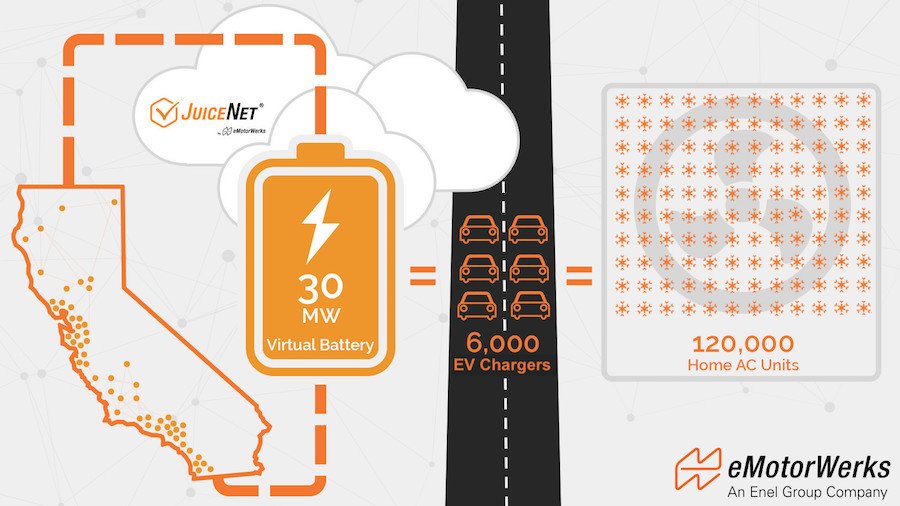V2G Is Happening: eMotorWerks Puts EV Chargers To Work As 30 Megawatt Virtual Energy Storage Battery

Hi Craig, This (concept in vehicle-to-grid) is one of the things we proposed in Bullish on Renewable Energy! Great to see it coming about. – Gary
Great to hear from you, as always, and yes, that’s great. I have no doubt that this will eventually become an important ingredient in sustainable energy/transportation.

Craig,
I’m always looking for extra positives for electric vehicles, but some ideas are more practical than others.
I’m afraid V2G is just one of those ideas which will prove of little attraction for EV owners and of little practical value.
EV batteries are mostly Lithium ion (cobalt) which age depending largely on the number of times they charge and discharge. Charging and discharged wear can be reduced by careful computerized monitoring of energy consumption during travel cycles. Although EV battery packs don’t develop memories, constant ‘forced’ charging and discharging will result in excessive wear and incur early battery replacement.
Since the battery pack is the single most expensive component in any electric vehicle, few owners will be eager to incur such an expense.
The majority of EV owners are avid users of home based solar power or us in the US, the Tesla recharging network.
V2G is the sort of idea that has great appeal to those who don’t actually own an an EV !
Marcopolo, I think you have not read the referenced article.
Vehicle to Grid is not really a good description of what this project is about. Rather it is a precurser of VTG in which smart charging is used to defer non urgent charging during peek times until either demand is lower or renewable energy production is higher. Chargers are aggregated to enhance grid stability.
As electric vehicles become more popular, it will become necessary to optimise use of the available grid capacity, or else have to invest massively in grid upgrades and generating capacity to allow everyone to charge whenever they like!
By deferring most charging until later in the evening, and ramping smoothly, the grid operator is better able to maintain grid stability.
It’s actually MY mistake for calling this V2G.
Gary,
I appreciate your point, but EV owners will follow whatever is the most convenient charging regime that accommodates their lifestyle. People will demand to “charge whenever they like”.
Patterns of EV usage and charging will be aided by smart technology, but charging will remain at the owners convenience, especially as wireless charging becomes more popular.
To achieve mass acceptance, EV’s will require a “breakthrough” or radical advancement in ESD technology which is currently inadequate to rival the convenience of gasoline-diesel.
I’m not disparaging improvements in electricity distribution, nor the value of improving grid efficiency, simply illustrating that consumers behaviour is difficult to predict with any confidence.
One of the early assumptions confidently predicted by EV enthusiasts and green advocates was EV’s would be successful because people “didn’t drive more than 60 miles per day”.
Countless surveys later and after hundreds billions of dollars spent producing failed ‘consumer’ EV’s, it was discovered that although consumers probably don’t drive as much they think, “range anxiety” is real and relatively few will contemplate a ‘commuter’ vehicle unless forced to do so by some form of government incentive or coercion.
New demands for energy such Data mining, crypto currency mining etc, are already providing massive challenges for electricity supply and the problem will continue to grow.
Your point is valid that better ‘smart’ technology will prove useful, but in the end a massive investment in infrastructure is inevitable.
How much people engage with smart charging I think depends on 2 factors.
1. Convenience. Ideally, you would use an app capable of voice or keyboard control, and instruct the charger to achieve a certain state of charge by a defined time e.g plug in the car on returning home from work and instruct “give me a minimum of 80% charge by 7.30am tomorrow”. The charger then has all night to fill the battery with rate and timing optimised for the grid.
2. Strong price signals making it several times more expensive to charge in the early evening on the hottest day of the year rather than at 3am when a weather front is passing through, and a glut of wind power comes on line.